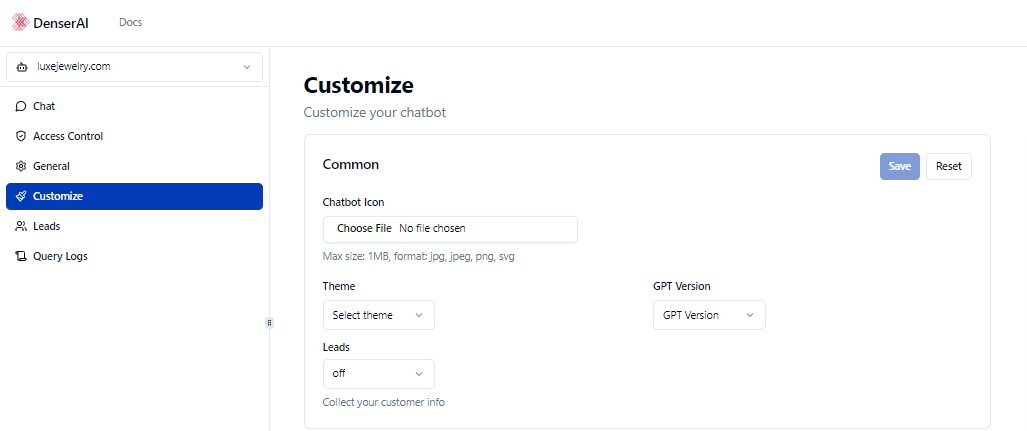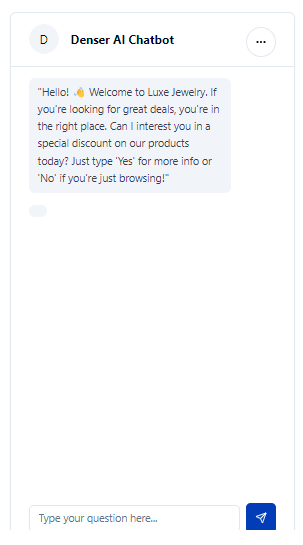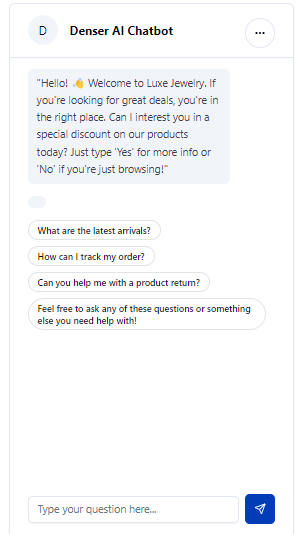Creating a chatbot doesn't require you to be a coding expert, thanks to the user-friendly features on many chatbot platforms. These tools often come with drag-and-drop features that simplify the process.
Yet, it can still feel intimidating if you're new to this or if technology isn't your strong suit.
In this article, we will walk you through each step to show how manageable creating a chatbot without coding experience is. By the end, you'll see it's not as complicated as it might seem, and you'll be ready to try it!
Why Does a Chatbot Matter for Your Website?
Businesses looking to improve their online service should add a chatbot to their website. It not only makes the site more interactive but also helps in managing communications more efficiently.
Here's a quick look at the benefits of a chatbot:
- Answers customer queries instantly
- Operates non-stop without extra staffing costs
- Handles several conversations at once
- Reduces the need for large customer service teams
- Collects valuable interaction data to refine business strategies
- Decreases bounce rates and improves site metrics through user engagement
Chatbots are becoming a common feature in businesses. According to statistics, their use by brands has grown 92% in recent years.
Moreover, having your own custom chatbot can significantly boost standard chatbot capabilities by being tailored to specific business needs.
Here are some concise benefits:
- Personalized customer experiences match the brand's tone and language
- Handles unique business challenges effectively
- Better functionalities like appointment booking and personalized recommendations
- Connects with existing business systems
Chatbot Tecnhologies
Chatbots that you interact with on websites and apps often feel surprisingly human-like. That's because they're powered by technologies such as Natural Language Processing (NLP) and artificial intelligence algorithms.
NLP helps chatbots understand human language so that they can respond more naturally and intuitively. Artificial intelligence helps them learn from each chatbot conversation, which means they better answer questions and handle requests over time.
Chatbots are proving quite effective in boosting sales, particularly in e-commerce. According to an Intercom survey, chatbots have helped increase sales by an average of 67%, and about 26% of all sales start with an interaction through a chatbot.
This shows how chatbots are not just for answering questions quickly. They engage customers and guide them through the buying process, which can lead to more sales.
It's clear that integrating conversational AI in customer service through chatbots can be beneficial for businesses.
Let's get started with our chatbot tutorial, which will show you how to create chatbots without coding skills.
How to Create a Chatbot Without Coding
These are the steps to creating a chatbot without coding:
Step 1: Define Your Chatbot's Purpose
Start by determining what you want your chatbot to achieve. Is it for answering customer queries, booking appointments, providing product recommendations, or something else?
Knowing its purpose will guide the rest of the development process.
Step 2: Select the Deployment Environment
Decide where your chatbot will operate. Will it be on your website, a social media platform, a mobile app, or multiple messaging platforms (such as Facebook Messenger or Instagram)?
This choice will affect how you design and integrate your chatbot.
Step 3: Choose a Chatbot Building Platform
Pick a platform that suits your needs and technical capabilities. Options vary from simple drag-and-drop interfaces for non-programmers to more advanced platforms that offer extensive customization.

Denser.ai is an intelligent chatbot that allows you to customize your chatbot easily by embedding to your website, which takes less than 5 minutes.
It's also essential to familiarize yourself with the two main types of platforms: AI frameworks and chatbot platforms.
Here's how each works and what they offer:
AI Frameworks
Those with programming knowledge generally use tools like Google's Dialogflow or Microsoft's Bot Framework. They are great for creating complex, smart chatbots that can learn over time and make personalized suggestions based on user interactions.
They also allow for more detailed integrations with other systems and services.
Chatbot Platforms
A no-code chatbot builder is more user-friendly and perfect for beginners or those who don't want to engage with coding.
Platforms like Denser.ai come with easy-to-use interfaces that involve dragging and dropping elements and chatbot templates to build your chatbot. They work well for answering frequently asked questions or helping users navigate your website.
Step 4: Design Your Chatbot's Conversations
Once you're logged in to your chosen chatbot builder platform, plan the flow of conversations. Decide how the chatbot should respond to different inputs and what actions it should perform.

Start by setting up the trigger, an event that activates your chatbot. For example, if you want your chatbot to greet visitors on a particular landing page, customize it in the "Initial messages" section. This sets the stage for the chatbot to initiate interaction.

You can also set up a few questions to provide immediate options for your customers:
Step 5: Test Your Chatbot
Before going live, thoroughly test the chatbot in various scenarios to ensure it responds correctly.
Make adjustments to fix any issues or improve the chatbot conversation flow.
Step 6: Train Your Chatbot
Enhance your chatbot's responses by training it with various possible user interactions.
This can involve feeding relevant data and using machine learning techniques if supported by your platform.
Step 7: Gather User Feedback
After a chat session, prompt users to complete a quick survey about their experience. Keep it short and focus on its responsiveness, helpfulness, and usability.
Incorporate simple feedback buttons (such as thumbs up/thumbs down) within the chat interface to allow users to express their satisfaction quickly.
Step 8: Analyze Chatbot Analytics
Keep an eye on how often the chatbot is used. High usage can indicate good engagement, whereas low usage might suggest that users need help finding the chatbot helpful or visible enough.
Analyze the logs of user interactions to see what questions are asked most frequently and how the chatbot responds. If your chatbot is set up for specific actions like signing up for a newsletter or completing a purchase, tracking the conversion rates can help you gauge its effectiveness in achieving these goals.
Dos and Don'ts of Building a Chatbot
When building an AI chatbot, it's important to follow best practices to ensure it delivers users a useful and enjoyable experience.
Here are some essential dos and don'ts to keep in mind:
Dos:
Keep the Design User-friendly
Design the chatbot's conversation flows to be intuitive and straightforward. Users should find it easy to navigate and get the information they need without confusion.
Use a Conversational Tone
Ensure your chatbot communicates in a friendly and engaging manner. A conversational tone can make interactions more pleasant and natural for users.
Continuously Improve
Use user feedback and chatbot analytics to refine and update your chatbot regularly. Improvements should focus on improving user experience and expanding capabilities based on user needs.
Don'ts:
Overcomplicate Your Chatbot
Avoid designing a chatbot that tries to do too much at once or uses overly complex language. Keep interactions straightforward to avoid overwhelming users.
Neglect User Privacy
Be transparent about data collection and respect user privacy. Ensure that your own chatbot communicates what data is being collected and how it will be used.
Not Have Human Escalation Options
While chatbots can handle many tasks, they could be better. Ensure users can easily escalate issues to a human if the chatbot cannot adequately address their concerns.
Not Test on Multiple Platforms
Test your chatbot platform first to ensure consistent performance across platforms (such as web, mobile, and social media).
Create Your No-Code Chatbot in Minutes with Denser.ai
Denser.ai combines the best of AI chatbot technology for a more human-like interaction. It offers chatbot solutions for everyone, from personal users to businesses of any size.

Here's a quick look at their full pricing plans:
Free Plan: This is ideal for individuals or businesses wanting to test the waters before committing to a paid subscription.
Starter Plan: $19/month, great for personal use, and offers all the basic features.
Standard Plan: $89/month, suitable for small teams and provides more capacity and features.
Custom Plan: Offers custom solutions perfect for larger businesses with specific needs. Pricing is based on your requirements, so you'll need to contact them.
Explore Denser's smart features by trying out a free trial or schedule a demo now.
FAQs About Chatbot Without Coding
How much does it cost to build a chatbot without coding?
Many platforms offer free basic versions, but premium features might require a subscription. Costs depend on the complexity of the chatbot and the scale of deployment. Generally, using a no-code platform is more cost-effective than developing a custom-coded chatbot.
What types of tasks can a no-code chatbot handle?
No-code chatbots are excellent for automating responses to frequently asked questions, booking appointments, and providing basic customer support. They can also assist with simple sales processes, such as product recommendations and gathering lead information.
Can a no-code chatbot handle multiple languages?
Many no-code chatbot platforms support multilingual capabilities, allowing you to design chatbots that can interact in different languages. This feature, however, might vary between platforms.
